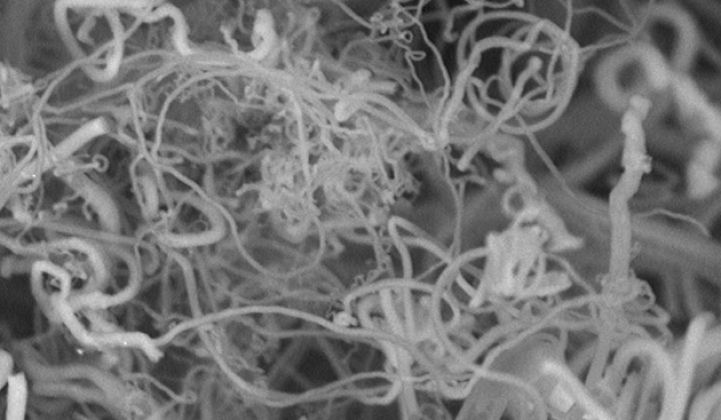Professor Stuart Licht has invented a process that can essentially make airplanes and wind turbines out of thin air.
Licht, a chemistry professor at George Washington University in Washington, D.C., has designed reaction that pulls carbon from the atmosphere and converts it into carbon nanofibers, a raw material that can be used to make strong composites for sports equipment, building material and aircraft like the Boeing Dreamliner.
“We’re very excited about this because carbon nanofibers are a very valued product,” said Licht in an interview. “So we think there’s going to be an impetus for bringing down carbon dioxide levels in the air.”
The process takes place in an electrochemical reactor, where nickel and steel electrodes are immersed in molten lithium carbonate at 1,380 degrees Fahrenheit (750° Celsius). Researchers then send in an electrical current and add regular, ambient air. The result: pure oxygen forms at the nickel electrode, while carbon nanofibers form like tiny bundles of steel wool at the steel electrode.
The steel electrode also produces lithium oxide, which reacts with carbon in the air to form more molten salt. And so the system continues on repeat.
Licht recently published a paper on his research, and gave a presentation this week at the American Chemical Society meeting in Boston, Mass.
The greatest benefit is that this process works efficiently, and with energy from green sources, said Licht.
His lab has demonstrated a unique solar energy conversion system that uses both the visible part of sunlight and the thermal energy of sunlight to achieve the heat level needed for the reaction. According to Licht, this process uses less than 1 volt of electricity to start creating carbon nanofibers at 750 degrees Celsius. By comparison, the industrial formation of aluminum requires 3 to 5 volts at 1,000 degrees Celsius.
Licht also claims he can make carbon nanofibers at far less than their retail price. Carbon nanofibers are currently worth approximately $25,000 per ton. Licht’s team calculates they could make a ton of the material using their process for about $1,000.
If it comes to fruition, this work would not only increase the affordability of carbon composites, but it could also have a huge impact on climate-change mitigation. According to Licht, an area less than 10 percent the size of the Sahara Desert would be sufficient to bring the concentration of carbon dioxide in the atmosphere down to pre-industrial levels within 10 years.
“But it will require a massive effort -- global resources, chemical engineers and mechanical engineers -- to scale up,” he said.
Indeed, scalability has proven to be an enormous challenge for all carbon-capture technologies. Researchers have been working for years on innovative ways to pull carbon from the air and sequester it safely, like in concrete. But these technologies have yet to prove economically viable.
Mississippi Power’s first-of-its-kind commercial carbon-capture and sequestration project has been an enormous liability. The Kemper plant is designed to create and burn synthesis gas made from lignite coal, and pump the resulting carbon emissions underground for enhanced oil recovery. The project is currently two years behind schedule and $4.4 billion over budget.
Licht said that his approach is different from traditional carbon-capture and sequestration processes. Sequestration involves the binding of carbon dioxide with various other substances -- so it could be bubbled into the ocean, stored under the earth, or extracted and concentrated. In Licht’s process, carbon dioxide isn’t added to something else; it’s transformed into something new. The fundamental science behind this work has good potential to scale, he said.
However, some in the scientific community have been critical of Licht's findings.
“I am extremely skeptical of these claims,” Ken Caldeira of the Carnegie Institution for Science in Stanford, Calif. told New Scientist. Caldeira said he doubts that Licht’s solar-to-chemical conversion technology is anywhere near economically viable. “I would be highly surprised if these people have cracked this nut.”



